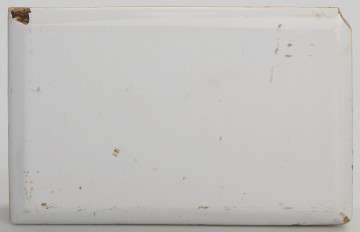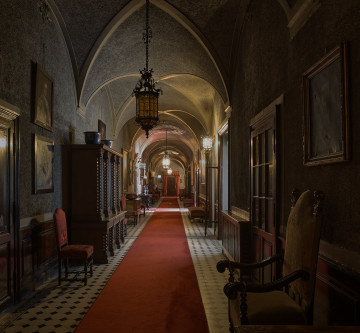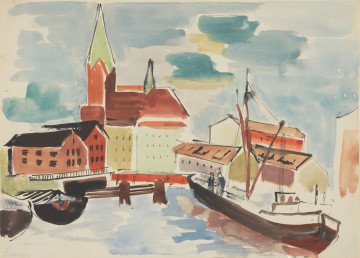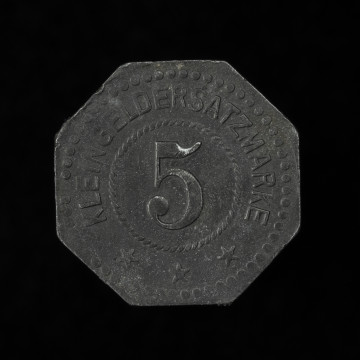
Stove tile
ante 1939
Museum of the history of Polish Jews
The cooker tiles in the POLIN Museum are an important part of the museum's collection of artefacts, expanding the collection to include material memorabilia of the Jews of Orla (the Bielsko-Biala poviat, the Podlaskie voivodeship). On the basis of individual items that have survived, we cannot reconstruct the micro history of a particular family, but they do allude to the lost world of the Jews of Orla.
The tiles donated by Paweł Nawrocki were discovered by him during demolition works in a house which he owns. There, he came across ceramic fragments bearing, among other things, the symbol of the Orla tile factory. It is not known how the cooker tiles from Orla came to the house near Warsaw.
A characteristic feature of the tiles is the mark of their manufacturer, in this case, the Wajnsztajn brothers' tile workshop. In this case, it was the Wajnsztajn brothers' tile factory. It operated in Orla as the largest factory in the region during the interwar period, employing several hundred workers. The brothers had two factories in Orla: in Bielska Street and at the corner of Krzywa and Bielska Streets. The factory produced tiles for building cookers. In the years 1939-1941 the factory produced tiles and funnels for collecting resin.
In the interwar period, the majority of Orla's inhabitants were Jews; according to estimates, they made up about three-fourths of the population (see https://sztetl.org.pl/pl/miejscowosci/o/682-orla/99-historia-spolecznosci/137796-historia-spolecznosci#footnote11_odlml1n). Due to Orla's unique position - in 1618, it was granted the privilege of free settlement, regardless of religion, by Krzysztof Radziwiłł - Orla's synagogues could legally surpass Christian churches (for more on architectural regulations of religious buildings, see MPOLIN-M720).
After a short presence of Germans in September 1939, Red Army soldiers quickly appeared in Orla. During the Soviet occupation, the Wajnsztajn family, among others, was deported to Kazakhstan in 1940, where they survived the war. The Wajnsztajns returned in a wave of repatriation and left Poland shortly after the Kielce pogrom. The story of the rescue of part of the Wajnsztajn family, as well as the return to Poland of a descendant of the owners of the tile factory - Sara Wajnsztajn - is recalled by Agnieszka Sowa in the article Pamięć o żydowskim miasteczku wskrzeszona (The Resurrected Memory of the Jewish Town) (see: https://www.polityka.pl/tygodnikpolityka/spoleczenstwo/1521146,1,pamiec-o-zydowskim-miasteczku-wskrzeszona.read, accessed 17 November 2021). In March 1942, the Germans established a ghetto in Orla, where Jewish residents were gathered. Unlike the Warsaw ghetto, it was not surrounded by a wall, but by a wooden fence, poorly guarded, which allowed smuggling to take place (it is worth remembering that ghettos were divided into three types: open, closed and liquidation, and thus differed topographically, on this subject see https://encyclopedia.ushmm.org/content/pl/article/ghettos, accessed 17 November 2021). Thus, the Jews of Orla managed to obtain food by barter through a poorly guarded fence (see on Orla in: Encyklopedia obozów i gett 1939-1945 (Encyclopedia of Camps and Ghettos 1939-1945), Vol. II, Getta w okupowanej przez Niemców Europie Wschodniej (Ghettos in German-Occupied Eastern Europe), Part A, ed. P. Megargee, M. Dean, Bloomington 2012, p. 930).
The tile factory and the Wajnsztajn brothers have been preserved in the memories of former Orla residents. They remember the tile factory as the main "breadwinner" for poorer families, for many people it was the main place of employment. The memory of Orla's pre-war residents has been preserved by Marek Chmielewski, mayor of the town, who together with his friends has published an album with archival photographs of Jewish residents. He has collected documents and Judaica. As a result of his actions, the local community has also become involved in commemorating and popularizing Orla's Jewish history. (On the initiatives taken by Marek Chmielowski see: http://dialog.org.pl/liderzy-dialogu/pl/lider/marek-chmielewski/, accessed 17 November 2021).
The Jews of Orla were taken to the extermination camp in Treblinka, no one survived.
Natalia Różańska
Znaleziono 15 obiektów

1629
Castle Museum in Łańcut

około 1930
National Museum in Szczecin

1916 — 1925
National Museum in Szczecin
DISCOVER this TOPIC
National Museum in Szczecin
DISCOVER this PATH
Educational path